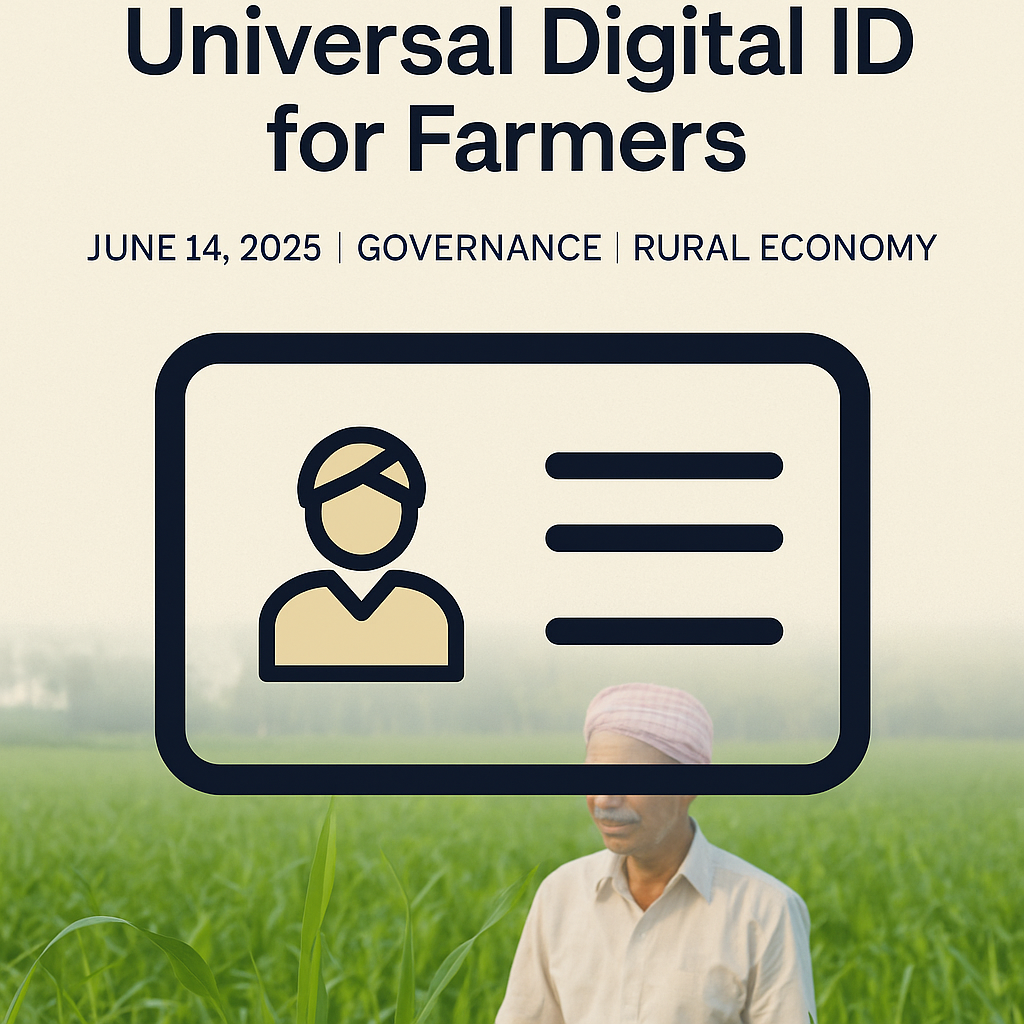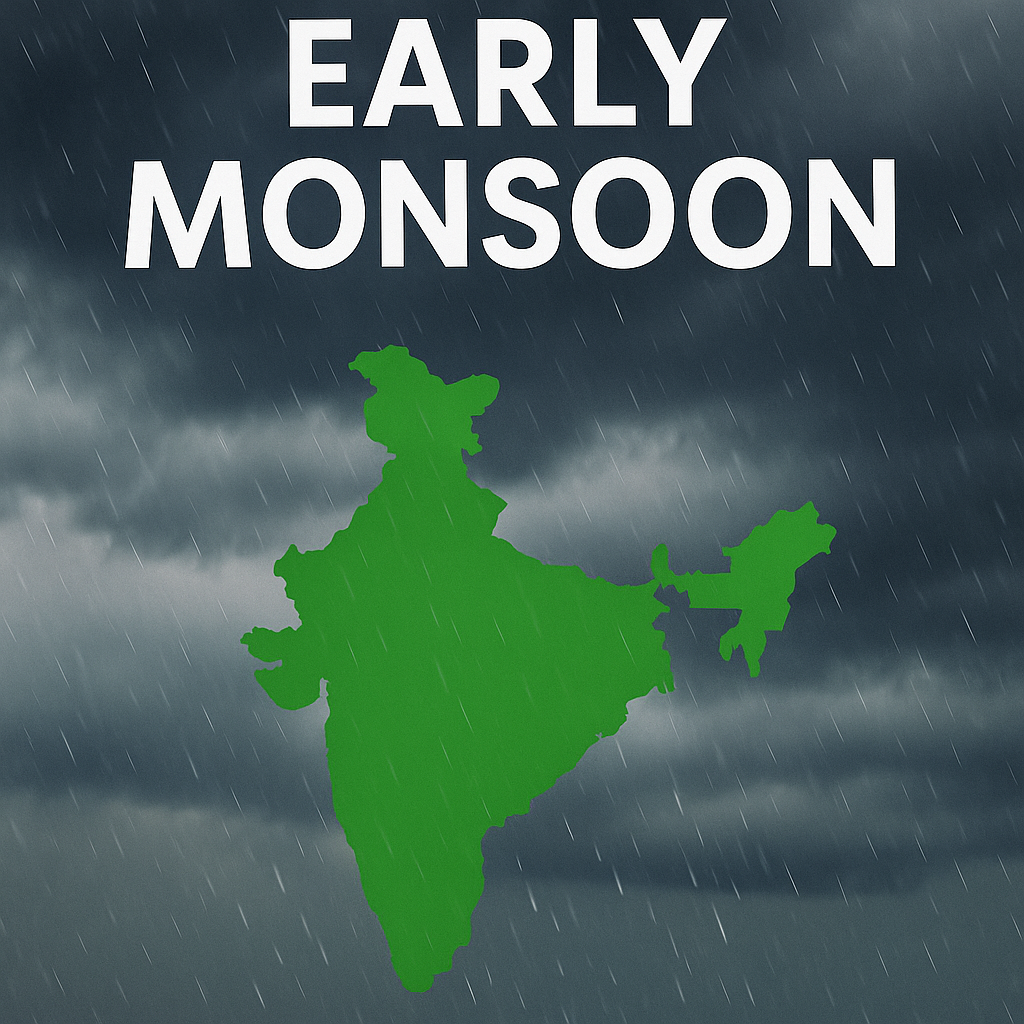
🧭June 14, 2025 Post 1: 🌱Centre Announces Universal Digital ID for Farmers | High Quality Mains Essay | Prelims MCQs
🌱Centre Announces Universal Digital ID for Farmers

NATIONAL
📅 Post Date: June 14, 2025
📘 Thematic Focus: Governance | Rural Economy | Digital Inclusion
🌀 Opening Whisper
“To sow trust in every acre, the State must first recognize the sower.”
🔍 Key Highlights
- The Government of India announced the rollout of a Universal Digital Farmer ID (UDFI) as part of a broader AgriTech governance push.
- This unique ID will link land records, Aadhaar, PM-KISAN eligibility, crop insurance status, and subsidy history of every registered farmer.
- The UDFI will be integrated with platforms like:
- DigiLocker (for certificate storage)
- eNAM (for market access)
- PM-Kisan and PMFBY (for benefits and insurance tracking)
- The pilot phase begins in Odisha, Maharashtra, and Uttar Pradesh, targeting 6 crore farmers in the next 12 months.
- The government claims this will help eliminate duplicate records, prevent leakages, and enable precision-targeting of farm subsidies and disaster compensation.
📘 Concept Explainer: What is the UDFI and How Will It Work?
- Each farmer will be issued a 16-digit alphanumeric ID, digitally linked to their landholding size, crop type, and bank account.
- The ID will function as a single-window credential for accessing all farm-related schemes.
- UDFI will be updated annually through a combination of drone-based land mapping, Gram Panchayat verification, and voluntary farmer declarations.
- It aims to unify fragmented databases and bring tenant farmers and women cultivators into the formal policy net.
🧭 GS Mains Mapping
- GS Paper 2 – Governance: E-Governance, JAM Trinity Expansion, Targeted Welfare Delivery
- GS Paper 3 – Agriculture: Farmer Welfare Schemes, Land Reforms, Agricultural Infrastructure
- Essay Paper – Bridging the Digital Divide in Rural India
💭 A Thought Spark — by IAS Monk
“If you want to feed a nation, begin by identifying the hand that tills its earth.”
High Quality Mains Essay For Practice :
Word Limit 1000-1200
Digital Identity for Farmers: Precision Governance for an Inclusive Rural Future
Introduction
In the age of Digital India, where citizens file taxes online and receive health records on mobile phones, Indian farmers—who form the backbone of the rural economy—have long been excluded from this data revolution. The recent announcement of a Universal Digital Farmer ID (UDFI) marks a transformative step toward precision-targeted welfare delivery, transparency in subsidies, and the inclusion of farmers within the formal governance ecosystem.
This essay explores the structure, significance, and challenges of the UDFI initiative, placing it within the broader context of e-governance, rural empowerment, and agricultural reform.
Why a Digital Identity for Farmers?
Despite the presence of several flagship schemes like PM-KISAN, PMFBY, and eNAM, India’s agriculture sector suffers from fragmented data systems, overlapping beneficiary databases, and leakages in subsidy delivery.
Consider these problems:
- Duplicate and fake beneficiaries receiving subsidies
- Inadequate tracking of crop failure compensation
- Lack of a unified registry linking land ownership, tenancy, and actual cultivation
- Difficulty in delivering real-time advisory and credit services to farmers
A Universal Digital Farmer ID intends to centralize and streamline all government-to-farmer transactions through a single, authenticated profile.
Key Features of the UDFI System
- Unique Identification
- Each farmer receives a 16-digit alphanumeric ID, similar in concept to Aadhaar but tailored to agrarian contexts.
- It will incorporate biometric and land-related verification.
- One Nation, One Farmer Record
- Consolidates entries across schemes like PM-KISAN, PMFBY, Soil Health Cards, eNAM, and credit-linked schemes.
- Eliminates duplication and ensures benefit targeting.
- Tech-Enabled Updating
- Drone-based land mapping and satellite verification will auto-update records on crop type, sowing area, and yield estimates.
- Integration with Bhoomi Portals (state land record systems) ensures accuracy.
- Tenant and Women Farmer Inclusion
- Flexibility to include leasehold cultivators, sharecroppers, and women co-farmers, previously outside formal recognition.
- Mobile-First Interface
- Farmers will access their profiles via smartphones or CSCs (Common Service Centres) using DigiLocker or Jan Dhan-linked OTPs.
How This Aligns with the Digital India Mission
The UDFI system is a natural progression of India’s JAM Trinity (Jan Dhan-Aadhaar-Mobile) framework. It extends digital governance into agriculture, a sector that employs over 50% of India’s population but has seen limited structural reform in recent years.
It reinforces the principles of:
- Minimum Government, Maximum Governance
- Direct Benefit Transfers (DBT)
- Data-driven policymaking and real-time monitoring
By creating a pan-India registry of cultivators, the State can better design schemes, forecast food supply, manage fertilizer demand, and even pre-empt agrarian distress.
Benefits and Transformative Potential
A. Precision Subsidy Delivery
Reduces fiscal waste by preventing overlapping claims, ghost beneficiaries, and misclassification of landholders.
B. Enables Smart Crop Insurance
With crop type and acreage linked to digital profiles, automated claims under PMFBY can be triggered using satellite data—speeding up payouts.
C. Strengthens Land Reform Process
Enables better detection of benami landholdings, encroachments, and assists in eventual land title digitization.
D. Improves Disaster Relief
After floods or droughts, UDFI can help quickly disburse compensation to verified landholders, avoiding delays due to manual surveys.
E. Women and Tenant Farmer Empowerment
Formal recognition allows access to loans, training, pensions, and insurance, especially for previously invisible cultivators.
Challenges and Concerns
Despite its promise, implementation faces significant hurdles:
1. Data Privacy and Surveillance Fears
Without robust data protection laws, the digitization of personal, financial, and land-related info could lead to misuse.
2. Exclusion Risks
If Aadhaar-like dependency is created without offline fallback mechanisms, vulnerable farmers (tribals, landless) may be excluded.
3. Land Record Inaccuracy
Many state land records remain outdated or contested—especially in states like Bihar, Jharkhand, and parts of the Northeast.
4. Technological Barriers
Only 30% of rural Indian farmers currently use smartphones. Rural digital literacy, especially among women, remains low.
Way Forward: Making UDFI Truly Inclusive
To make UDFI effective and equitable:
- Pilot first, then scale – Start with 3–5 states, test data accuracy, revise before full launch.
- Combine with land reforms – Modernize land records in mission mode alongside UDFI roll-out.
- Establish grievance redressal mechanisms – Set up helplines and field officers to resolve misidentification or technical barriers.
- Ensure women’s co-ownership – Mandate joint ID generation for women cultivators in family landholdings.
- Legal framework for data protection – Enact an agriculture-specific data governance act or extend coverage under the upcoming Digital Personal Data Protection Act.
Conclusion
The Universal Digital Farmer ID is not just a technical reform—it is a moral and economic step toward recognizing India’s most foundational workforce. In giving farmers a digital face, the State signals that welfare cannot be delivered blindly—it must be targeted, timely, and transparent.
If implemented with integrity, caution, and inclusivity, UDFI could revolutionize rural governance, enable smarter policymaking, and bring India’s 21st-century aspirations closer to the soil that sustains it.
Because only when the farmer is seen clearly, can the nation feed freely.
Target IAS-26: Daily MCQs :
📌 Prelims Practice MCQs
Topic: Digital Identity for Farmers: Precision Governance for an Inclusive Rural Future
MCQ 1 – Type 1: How many of the above statements are correct?
Consider the following statements regarding the Universal Digital Farmer ID (UDFI):
1. It will consolidate databases from PM-KISAN, crop insurance, and eNAM into a single platform.
2. The UDFI will be issued only to land-owning farmers and exclude tenant cultivators.
3. It aims to reduce subsidy duplication and leakages.
4. UDFI will include a 16-digit alphanumeric ID linked to Aadhaar and land records.
A) Only two
B) Only three
C) All four
D) Only one
🌀 Didn’t get it? Click here (▸) for the Correct Answer & Explanation
✅ Correct Answer: B) Only three
🧠 Explanation:
•1) ✅ True – Consolidation is a key objective.
•2) ❌ False – Tenant farmers and women cultivators will also be included.
•3) ✅ True – Targeting subsidies efficiently is a stated benefit.
•4) ✅ True – UDFI includes 16-digit ID with Aadhaar/land linkages.
MCQ 2 – Type 2: Two Statements Based
Consider the following two statements:
1. The JAM Trinity forms the foundation for digital welfare initiatives like UDFI.
3. PMFBY crop insurance is not expected to be integrated with the UDFI system.
A) Only 1 is correct
B) Only 2 is correct
C) Both are correct
D) Neither is correct
🌀 Didn’t get it? Click here (▸) for the Correct Answer & Explanation
✅ Correct Answer: A) Only 1 is correct
🧠 Explanation:
•1) ✅ True – Jan Dhan, Aadhaar, and Mobile form the infrastructure backbone for UDFI.
•2) ❌ False – PMFBY will be integrated to streamline claim processing.
MCQ 3 – Type 3: Which of the statements is/are correct?
Which of the following are key challenges in implementing the UDFI?
1. Outdated and contested land records
2. Digital illiteracy among rural farmers
3. Lack of political will for agrarian reform
4. Privacy concerns due to absence of legal safeguards
A) 1, 2 and 4 only
B) 2 and 3 only
C) 1, 2 and 3 only
D) All four
🌀 Didn’t get it? Click here (▸) for the Correct Answer & Explanation
✅ Correct Answer: A) 1, 2 and 4 only
🧠 Explanation:
•1) ✅ True – Land data accuracy is a known barrier.
•2) ✅ True – Tech access and digital literacy are uneven.
•3) ❌ False – The policy has strong political backing.
•4) ✅ True – Data protection laws are not fully in place.
MCQ 4 – Type 4: Direct Fact
Which of the following states is NOT part of the pilot rollout for the UDFI as announced in June 2025?
A) Maharashtra
B) Odisha
C) Uttar Pradesh
D) Punjab
🌀 Didn’t get it? Click here (▸) for the Correct Answer & Explanation.
✅ Correct Answer: D) Punjab
🧠 Explanation:
•The pilot begins in Odisha, Maharashtra, and Uttar Pradesh—Punjab is not among the initial rollout states.


















